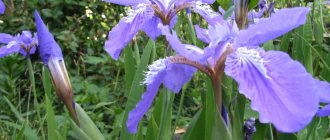Previously known to everyone exclusively as a wildflower, cornflower subsequently took on a cultivated form and settled in many flower beds as an ornamental plant. And its various varieties today boast more than just shades of blue.
Garden cornflowers have one difference visible to the naked eye from meadow plants of this species: they are decorative and are distinguished by larger flowers. And most importantly: the rich blue shade of the buds, which is familiar to us, has been replaced by a variety of colors of cultivated species and varieties. By the way, among the inhabitants of flower beds there are also cornflowers, which are radically different from the original even in the appearance of the flowers: they are denser and fluffier, and we will also tell you about them.
There are two versions of the origin of the word centaurea - the Latin name of the plant. One of them, mythological, claims that with the help of cornflower the centaur Chiron was healed from the poison of the Lernaean Hydra. Another says that this flower was called that way even under Hippocrates, and translated from Greek its name literally sounds like “stabbing bulls.”
Classic Fantastic
An annual or biennial flower in cool blue shades, from light sky and blue to dark blue, as well as two-tone blue and white. Grows up to 100 cm in height and up to 30 cm in width. Unpretentious to grow. Looks especially good in borders and as part of a Moorish lawn. Flowering is abundant and long lasting - from June until frost.
- Low-growing plants for hedges and borders
Emphasize the beauty of the landscape with a low hedge up to 1 m high.
Cornflower petals of some varieties (for example, Classic Fantastic) are used in cooking - added to salads, sprinkled on omelette or pasta.
Master classes on making beautiful bouquets of wild flowers
One of the most important points in composing a bouquet of wildflowers is the selection of plants and materials.
It should be said that a good addition to such compositions can be:
- dried flowers;
- ears of cereals;
- feather grass panicles;
- conifer branches;
- burdock leaves;
- plantain;
- blueberry;
- greenery of ferns and daylilies;
- asparagus.
To create bouquets you may need:
- sharp scissors;
- pruner;
- wire cutters;
- oasis (special floral sponge);
- floral adhesive tape (elastic or paper);
- thin wire;
- twine;
- additional plant and decorative elements mentioned above.
A simple bouquet of lupins, buttercups and cress using spiral technique
When collecting flowers for a bouquet, you need to have a container of water with you so that the plants are well saturated with moisture and can be used further in work.
Tools and materials for decorating a bouquet:
- sprigs of purple lupins, yellow buttercups and cress;
- pruner;
- scissors;
- twine;
- decorative wide ribbon (braid).
Operating procedure:
- Strip the lower parts of the stems of flowers from leaves by ⅔ of the total length.
- Select a long buttercup branch and attach another 1-2 branches of colza to it at an angle, also at an angle.
- Place the lupine stem on top of the previous buttercup branches laid at an angle, gradually turning all the stems.
- The shorter stems of ranunculus and colza are placed lower (this gives depth to the bouquet), and dark lupins are placed higher in the bouquet.
- When laying each subsequent branch, you should set an even greater angle of inclination (this gives a more spherical shape to the bouquet)
- Place all prepared stems at an angle.
- Inspect the resulting bouquet and, if necessary, correct flower branches that are out of the composition.
- Tie twine around the stems at the junction in a spiral.
- Trim all stems with pruning shears.
- Wrap the tying area with decorative braid, cut at an angle of 45 degrees.
A simple beautiful bouquet of wild purple and yellow flowers is ready.
Bouquet of field daisies, speedwell, solidago and tlaspi
To work you will need:
- branches of field daisies (matricaria);
- paniculate bright blue and light blue twigs of speedwell (snake grass);
- bright yellow fluffy branches of solidago (common goldenrod);
- white long inflorescences of tlaspi (field grass);
- scissors and pruning shears;
- twine;
- decorative tape.
Operating procedure:
- Remove leaves from plant stems.
- Lay the longest stems of daisies and speedwells overlapping each other at an angle, gradually turning them in your hands.
- Next, gradually alternating, also lay yellow solidago panicles and white tlaspi inflorescences at an angle in descending order.
- By laying all the flower stems one by one, it is necessary to achieve a spherical shape of the bouquet.
- Straighten and trim branches and stems with pruning shears.
- Tie the bouquet with twine at the intersection of the stems.
- Wrap the bouquet with decorative ribbon over the binding.
A beautiful lush bouquet is ready.
Bouquet of tansy, cornflower and fern
To work you will need:
- cornflower flowers;
- sprigs of bright yellow tansy;
- branches of green fern;
- twine;
- scissors and pruning shears;
- decorative braid or ribbon.
Operating procedure:
- Remove leaves from flower stems.
- Overlap 3 branches of tansy at an angle. They will determine the height of the bouquet.
- Next, lay several more rows of tansy in the same way, turning them in your hand.
- Then add sprigs of bright blue cornflower, alternating them with tansy stems.
- Subsequent stems are shortened. The bouquet should be round and lush.
- Lastly, fern branches are woven into the bouquet. They are placed in the same way as the previous stems in a spiral and frame the entire bouquet.
- Tie the bouquet at the intersection of the stems with twine
- Trim the length of the branches with pruning shears.
- Decorate the attachment point with ribbon.
A bright and unusual bouquet is ready.
John Coutts
Large pink or purple flower with a white center. Capable of growing up to 50 cm in height and width. The plant is rich in pollen, so it performs an additional function by attracting living helpers - bees - to your site. Perennial, frost hardy, ideal for mixed herbaceous borders, gardens or containers where it will bloom continuously from June to September.
- DIY container garden - 6 tips for creating and maintaining
A landscape designer from Belarus shares his personal experience in creating an unusual container garden.
It is best to grow this cornflower in well-drained soil in a sunny or partial shade location. And if you regularly remove wilted leaves and stalks, you can sometimes prolong its flowering. By the way, this is also true for some other varieties of cornflowers. Does not have toxic effects on people and animals.
Amethyst in Snow (Amethyst in Snow, Amethyst in the snow)
The Amethyst in the Snow cornflower is a bicolor flower with silky white tube-shaped petals that emerge outward from a sharp purple center. It can grow up to 50 cm and in width up to 1 m.
This cornflower gets its interesting name because its core is actually similar in color to the amethyst gemstone. And the white petals surrounding it resemble snow. Literally translated into Russian, the name Amethyst In Snow means amethyst in the snow. The plants form dense masses, which makes it an integral part of any flower garden - edging, mixborder, front garden or rock garden.
For best flowering, this cornflower is grown in an open sunny area in neutral or alkaline soil with good drainage. The plant requires division every 2-3 years. Its flowering occurs at the end of spring - beginning of summer. This means that it is advisable to plant nearby plants that bloom throughout the season or arrange a flowerbed of continuous flowering.
- How to beautifully decorate a flowerbed of continuous flowering with your own hands
Popular flowers for flower beds that bloom all summer, photos for inspiration, as well as colorful diagrams and useful recommendations!
Bride (Bride)
An unpretentious annual with large fragrant white flowers. This stunning snow-white cornflower is ideal for cutting. Its height is 60-100 cm, and the diameter of the flower is about 30 cm. In the strict sense of the word, it is not even very similar to the traditional cornflower. And only the characteristic structure of the flower indicates that it clearly belongs to the Asteraceae family.
The tubular flowers are very elegant due to the deeply cut edges of the corolla. An ideal “candidate” for a place of honor in any bouquet, it will, however, be able to decorate any flower bed on your site, especially since it blooms from May to July.
- What types of flower beds are there?
What is the difference between a flowerbed and a front garden, and a rockery from an alpine hill?
To increase the splendor of the plant, it is necessary to periodically pinch it.
How to make a bouquet in a basket
Bouquets of wildflowers (photo below in the text) in baskets can be presented as a gift or used as interior decoration. They look very delicate and colorful, no worse than exquisite pompous bouquets of expensive flowers. It should be remembered that the shape of the bouquet must match the shape of the basket.
To create a composition of field daisies in a basket you will need:
- field daisies;
- sprigs of gypsophila;
- small bushy roses;
- oasis (floral sponge);
- a container of water to prepare the oasis;
- a round basket made of wicker of the required size;
- cellophane transparent;
- synthetic rope;
- scissors and pruning shears.
Operating procedure:
- Prepare gypsophila flowers and branches by cutting them to the desired length at an acute angle.
- Cut the floral sponge to the size of the basket.
- Place the finished oasis in a container on top of the water. You should wait until it is completely saturated with water on its own.
- Place cellophane film in the basket.
- Place the water-soaked oasis in the basket on the film.
- Trim off excess film.
- Secure the floral sponge by threading the string crosswise through the basket bars.
- Insert daisies over the entire surface of the oasis at an equal distance from each other. They should stand vertically in the center. In the direction from the center to the edges of the basket, the flowers are installed at an angle.
- Place roses separated from a single branch between the daisies.
- Insert sprigs of gypsophila along the edge of the oasis. They will hide the voids between the edge of the basket and the flowers, and also add tenderness and splendor to the bouquet.
Frosty
A multi-colored, unpretentious annual up to 80 cm high. Delicate double flowers are collected in inflorescences shaped like baskets. Frost-resistant, prefers sunny places and well-drained soil with a neutral acidity level. The plant is drought resistant.
Frosty's cornflower gets its name from its white border, which, when viewed from a distance, gives it the appearance of a frost-covered flower.
Looks great either cut as part of a bouquet or in any flower bed. Blooms from June to September.
Additional Tips
In order for the bouquets and flower arrangements you create to please you with their beauty and uniqueness, you should adhere to some rules and recommendations:
- Collecting wildflowers for bouquets should be done in the morning or evening, avoiding doing this in hot weather in the sun.
- To collect flowers and transport them, you should stock up on a container of water or a large piece of damp cloth for wrapping the cut plants.
- You should not pick flowers. They must be cut with pruning shears at an acute angle. This will help the plants absorb moisture better.
- You should not hold cut flowers in your hands. They will quickly wither from the living heat. It is better to wrap the stems with a bag or torn large leaves.
- When collecting wildflowers, it is better to immediately sort them by type and transport them separately, since some of them cannot live next to each other and accelerate the withering process.
- Flowers and plants with hollow stems do not absorb water well. To preserve their presentable appearance, you can insert a piece of cotton swab into the cut cavity on the stem. This will provide greater hydration and moisture saturation.
- Collected flowers and herbs should be cleared of leaves and thorns to avoid accelerating the putrefactive process in the bouquet, which will stand in a vessel with water.
- When preparing flowers for work, it is necessary to give them plenty of water.
- When working with an oasis (floral sponge), you should not move flowers from place to place several times. The holes in it will not be restored. A flower placed next to them will not hold up.
- When placing flowers in a basket, you should always focus on the center point. It determines the entire arrangement of the composition.
- In the center the flowers stand vertically. Closer to the edges they should be given a horizontal position.
- When placing flowers in an oasis, you should remember that the length of the cut stem should have a margin of 1.5 cm. It is to this depth that the flower will be inside the floral sponge to receive moisture and nutrition.
- When decorating a basket with flowers, you should periodically rotate it so that the composition is evenly distributed.
- To create bouquets of wildflowers, you should select vessels that match their size and design. The more magnificent the bouquet, the more modest the vase should be.
Beautifully and competently composed bouquets are always pleasing to the eye. And wildflowers look touching in any composition, even in photographs. Even if their lifespan outside of wildlife is short, they can give a lot of pleasant emotions, the smell of summer and a romantic mood.
Black ball (Black Ball, Black ball)
An annual plant with burgundy-violet (sometimes chocolate) flowers. Grows up to 75 cm in height and up to 30 cm in width. This cornflower is recommended to be grown in moist, well-drained soil in an open, sunny location. Blooms from June to August. You can extend this phase by immediately removing the dried stalks.
Blackball cornflower is so rich in nectar and pollen that it will attract beneficial beetles and other insects, as well as birds, to your garden.
- 7 beetles that every summer resident should take care of
Before squashing a beetle that comes into your field of vision, examine it carefully. Perhaps this is one of those who protect our gardens and vegetable gardens from pests.










